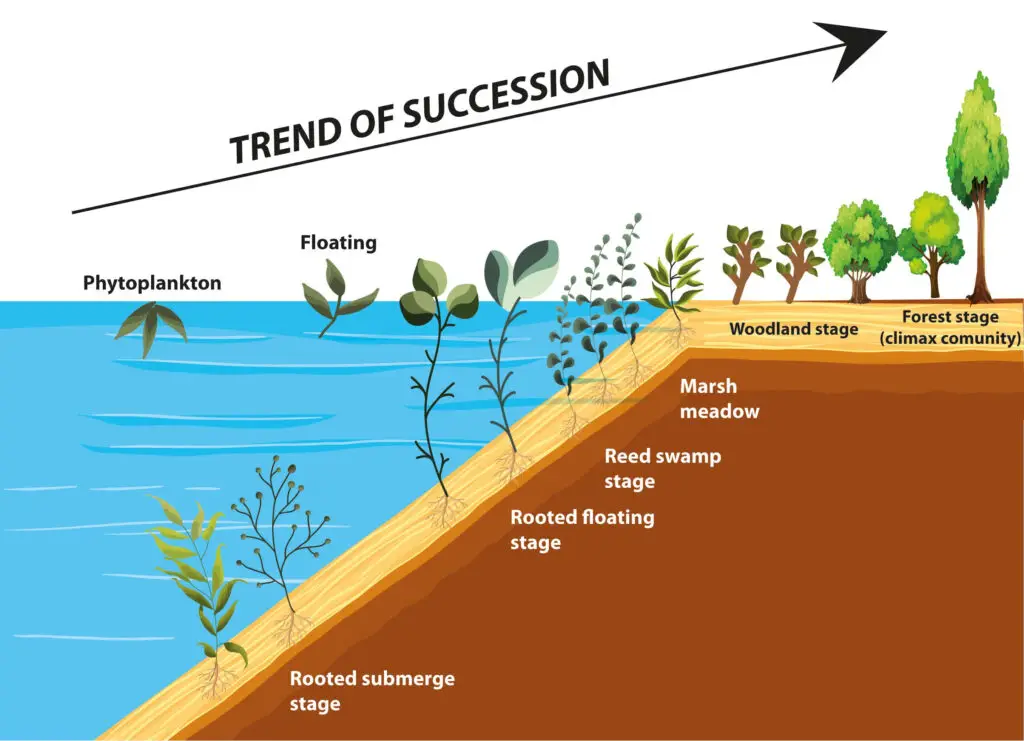Advertisements
Table of Contents
- In ecological terms, the stages of a community’s development are called seral stages, and the last stage is called the climax community.
- The first group of people to live in an area, which is replaced over time by a series of new groups until the climax, is called the pioneer stage.
- A sere is the name for the whole group of communities that live in one place.
- A series of species is defined not only by changes in the sets of populations, but also by an increase in the number of species and the total amount of living matter.
- In a given area, the order of seres is often completely predictable, both in terms of the general types of population to be expected at each sere and the length of each sere.
- On land, for example, a forest community is often a good example of a climax stage. If the original physical environment was sand, then the order of species is: soil-forming organisms (bacteria, lichens, mosses, and fungi), annual grasses, perennial grasses, shrubs, and trees.
- Each of these different plant populations has its own group of animals that live with it.
- It can be shown that it may take about a thousand years for a desert to turn into a forest. If the starting point is land that has already been farmed, that is, if there is already soil, a grass climax may be reached in about 50 years and a forest climax in about 200 years.
- Here, it’s important to note that the soil is gradually used up in certain ways as the same plants reproduce.
- Also, when plants die, their bodies add things to the soil that are often bad for the next generation of the same plant.
- So, both specific depletion of soil and specific additions to it can cause plant and animal populations that depend on those plants to change over time.

Classification of Seres community
Seres are classed mostly based on the amount of water in the first environment in which they originate. There are two primary types: hydrosere and zerosere.
1. Hydrosere
- The successions that originate in ponds, lakes, marshes, or other bodies of water are referred to as hydrarchs, and the several stages of the sereis or sere comprise a hydrosere.
- Weaver and Clements (1937) have outlined a series of steps by which a region covered by deep water becomes a forest.
- The numerous stages—submerged stage or plants, floating plants, reed-swamp plants, sedge-meadow plants, woody plants, and climax forest—are almost cross-sections of a continuous evolution based on key places when, due to more or less pure dominance, change is most obvious.
- This entire developmental process can be observed along lake borders, where each stage is represented by a distinct zone.
- As the lake bottom is built up, the horizontal phases from shallow water to marginal forest become arranged in a vertical succession, with forest forming the top layer.
2. Xerosere
- Successions that start on bare rock, wind-blown sand, or other places with very little water are called xerarchs, and the different stages of growth are called xeroseres.
- The different stages of xerosere are the crustose-lichen stage, the foliose-lichen stage, the moss stage, the herbaceous stage, the shrub stage, and the climax forest stage.
- In the xerosere, the habitat goes from being very dry to having a medium amount of water, and the plants, which were at first adapted to the dry conditions, change into a mesophytic forest.
Prisere and Subsere
Seres (bioseres) are put into the following groups based on the type of area where they grow:
Advertisements
1. Priseres
- Seres on primary areas, which are places where plants used to grow, are called primary or priseres.
- With priseres, the extremes are clear, and the water quality becomes a controlling factor as well.
- So, hydroseres in areas with a lot of salt are called haloseres.
- Also, the surface of rocks and dune sand may be almost as dry, but they are very different in terms of how hard they are and how stable they are. The rocks are called lithoseres and the sand ones are called psammoseres.
2. Subseres
- Subseres are seres that grow in areas that have been burned, flooded, or otherwise stripped of plants.
- Extreme conditions of water content are rare in subseres, or they only last for a short time.
- So, it’s enough to know about hydrosere and xerosere as the only two subdivisions.
